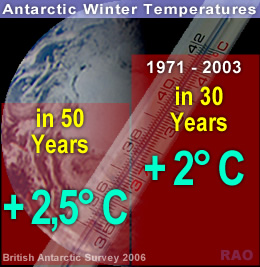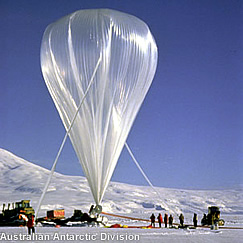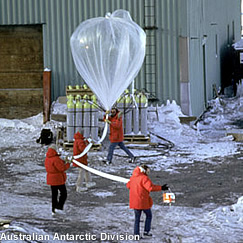 |
Klimawandel Informationen |
|
 |
Klimawandel Informationen |
|
|
Informationen
über den Klimawandel
|
März
2006
 Bedeutende
Erwärmung der Troposphäre über der Antarktis Bedeutende
Erwärmung der Troposphäre über der Antarktis |
| Studie
der Britische Antarktisforschung "British Antarctic Survey" (BAS) |
 |
|
Significant
warming of the Antarctic winter troposphere
|
 |
 |
| A
new analysis of weather balloon observations from the last 30 years reveals
that the Antarctic has the same 'global warming' signature as that seen
across the whole Earth, but is three times larger than that observed globally.
The
results by scientists from British Antarctic Survey are reported
in Science magazine.
Although
the rapid surface warming in the Antarctic Peninsula region has been known
for some time, this study has produced the first indications of broad-scale
climate change across the whole Antarctic continent. |
|
Lead
author Dr John Turner of the British Antarctic Survey says,
"The
warming above the Antarctic could have implications for snowfall across
the Antarctic and sea level rise. Current climate model simulations
don't reproduce the observed warming, pointing to weaknesses in their ability
to represent the Antarctic climate system. Our next step is to try
to improve the models."
|
Daily
launches of weather balloons
|
 |
 |
| Daily
launches of weather balloons have been carried out at many of the Antarctic
research stations since the International Geophysical Year of 1957-8. The
balloons carry instrument packages called radiosondes that measure temperature,
humidity and winds up to heights of 20 km or more. Recently many of the
old radiosonde records have been digitised and brought together in a project
funded by the Scientific Committee on Antarctic Research.
Analysis
of the radiosonde data showed a winter season warming throughout the troposphere,
which extends up to about 8 km, and cooling in the stratosphere above. |
|
The largest warming of almost three quarters of a degree Centigrade per
decade was found close to 5 km above the surface.
This
is over three times the rate of warming observed for the world as a whole.
The warming has occurred across the whole of the Antarctic and is apparent
in the balloon data from Amundsen-Scott Station at the South Pole to the
many stations along the coast of East Antarctica.
Although
climate change at the surface of the Earth receives wide attention, the
atmosphere in recent decades has in fact warmed most some 4-5 km above
the surface, with the stratosphere cooling above.
 |
| There
is increasing evidence that levels of greenhouse gases have provided a
blanket above the Earth trapping heat at lower levels and giving cooling
in the layers above.
Air
temperatures in the Antarctic Peninsula region have risen by over 2.5°C
in the last 50 years, about 5 times faster than the global mean rate.
In
recent decades both Polar Regions have shown very contrasting patterns
of change at the surface, with the Arctic warming markedly, while there
has been little change in the Antarctic outside of the Antarctic Peninsula
region.
Changes
above the surface have not been investigated previously. |
|
British
Antarctic Survey is a world leader in research into global issues in an
Antarctic context. It is the 's national operator and is a component of
the Natural Environment Research Council. It has an annual budget
of around £40 million, runs nine research programmes and operates
five research stations, two Royal Research Ships and five aircraft in and
around Antarctica.
The
paper 'Significant warming of the Antarctic winter troposphere' is published
in Science on 30 March 2006.
Source:
British Antarctic Survey, 30. March 2006
Issued
by the British Antarctic Survey Press Office |
 |
top
|
Links
|

|
 |
 |
Externe
Links |
|







